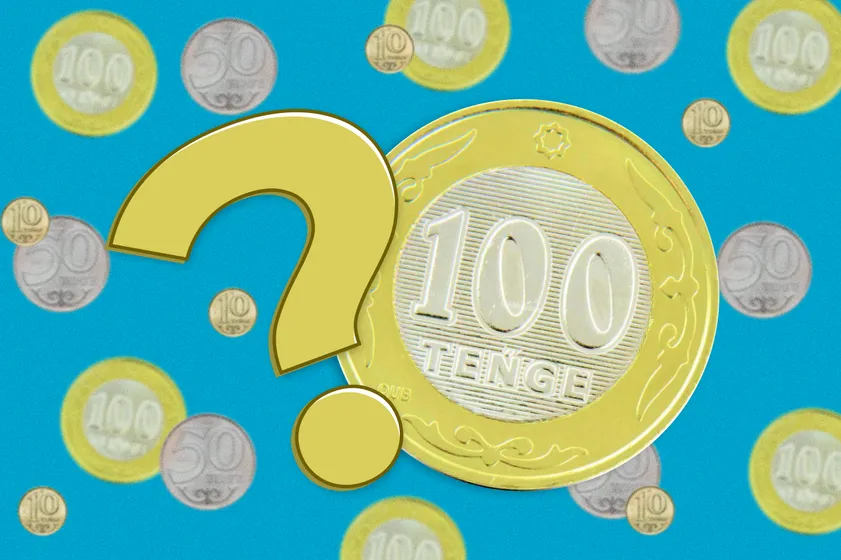As we commemorate the 30-year anniversary of the tenge, it is the perfect moment to put your currency knowledge to the test. QazMonitor prepared a quiz that delves into various facets of the tenge, covering everything from its historical journey to intriguing and unexpected facts about Kazakhstan's official currency.
Name evolution of tenge
Initially, the proposed names for the currency included "som," “sum”, “aksha”, “altyn”, and others. However, the Kazakh currency's name changed to "tenge" after Kyrgyzstan adopted the Kyrgyz som in 1993.
The name "tenge" was proposed by Sauk Takezhanov, a renowned scholar in the field of metallurgy. This historical name is derived from the Turkic word "tenge," which directly translates to "money". One-hundredth of the currency was called "tiyn", meaning “coin” in Kazakh.
Inaugural Batch
In 1991, a design team, comprising Mendybay Alin, Dosbol Kasymov, Agimsaly Duzelkhanov, Timur Suleimenov, and Khayrulla Gabzhalilov, was formed to craft the design of the new currency. By August 1992, the National Bank formally approved the initial banknote designs.
The inaugural batch of tenge coins was manufactured by Harrison & Sons, a globally renowned banknote printing company with a 400-year history. Transported with utmost confidentiality, four IL-76 planes made 18 flights between Uralsk and London. Today, the currency is produced at a mint in Ust-Kamenogorsk and a banknote factory in Almaty.
Commemorative tenge coins
Following the formal establishment of the national currency, various commemorative tenge coins emerged in the market. They represent a fascinating blend of numismatic artistry and cultural significance. The first batch of commemorative tenge coins, introduced on October 18, 1995, featured non-precious metal coins dedicated to the 50th anniversary of the UN. On December 5 in the same year, the first commemorative coin made of silver was released to honor Abay Kunanbayev's 150th birthday, emphasizing the enduring legacy of the celebrated poet.
Over the past 30 years, Kazakhstan has issued over 340 commemorative collections of coins made of non-precious metals, silver, gold, and bimetals. The collections are dedicated to historical figures, animals, architecture, significant milestones, and more.
Most expensive banknotes and coins
Collector banknotes hold immense significance for numismatists, who often find these specialized banknotes to be particularly valuable due to their unique designs, limited editions, or historical relevance. The rarity and exclusivity of collector banknotes make them highly sought after, and enthusiasts are willing to pay substantial amounts to add these pieces to their collections.
The Calypso banknote, valued at 990,000 tenge, stands out among the most expensive collector’s tenge banknotes. Crafted in collaboration between the National Bank of Kazakhstan, De La Rue Currency, and SICPA, the Calypso banknote's intricate design involved over 50 sketches by artist Mendybay Alin.
As for the coins, the 5,000 tenge coin commemorating Kazakhstan's independence is noteworthy for its value of 7 million tenge. Made of 925 silver and weighing one kilogram, this coin is a tangible embodiment of Kazakhstan's historic milestone.
Historical Figures
Collector banknotes often feature depictions of historical figures to convey cultural and historical significance. One of those figures is the legendary explorer Marco Polo, who graces the front side of the tenge banknote, capturing the spirit of exploration. The bill also features the outline of an ancient yurt, adding a touch of cultural richness. In the center, the inscription reads "THE GREAT SILK WAY."
This tenge banknote stands out as one of the rare instances where a non-Kazakh historical figure was featured on the bill. Earlier, circulation banknotes showcased significant figures in Kazakh history such as Abay, Abylai Khan, Al-Farabi, and more. However, in later designs, the themes shifted to include diverse elements from the natural world, incorporating depictions of animals and birds.
Unique coin shapes
Some collector tenge coins come in unique shapes—triangles, for instance! The silver coin "Tumar" from the "Magical Symbols" series with a denomination of 100 tenge represents a traditional Kazakh amulet.
The upper part of the coin has a hole, allowing it to be worn as an actual amulet by attaching a cord or chain.
Other interesting shapes include rectangle coins to commemorate the memory of Batyrkhan Shukenov, a talented musician and author of many popular songs. It was the first collaborative coin aimed at supporting contemporary youth art and initiating the new series "Exploring Coins – Discover Kazakhstan."
LL Series and Tactile Elements
Mistakes happen, even in the currency manufacturing industry. This is why certain banknotes incorporate the letters 'LL' before the serial number as a security measure against counterfeiting. Banknotes are typically issued in a predetermined quantity, but when production defects occur, defective banknotes are replaced by LL series banknotes to maintain the designated volume. As the LL series is often rare, some collectors exclusively seek banknotes from this series.
Another interesting distinguishing feature of a tenge banknote is that the front side has raised relief elements at the top of the banknote, providing a tactile feature that aids individuals with impaired vision to identify banknotes.
A peek into the future: digital tenge
The Digital Tenge is a new form of national currency in Kazakhstan, designed to coexist alongside physical and non-cash currency. The digital currency will be universally accepted as a legal means of payment, issued in unique digital sequences stored on electronic wallets.
On November 15, a presentation was held to unveil the preliminary results of the project for implementing the digital tenge at the XI Congress of Financiers of Kazakhstan in Almaty. The National Bank of Kazakhstan has launched the digital tenge platform in a pilot mode, involving second-tier banks and their clients.
In other recent releases, the National Bank unveiled TEŃGEGE 30 JYL collector coins, part of the "Outstanding Events and People" series, celebrating the 30th anniversary of the tenge. The coin design incorporates the tenge symbol ‘₸’ surrounded by binary codes, emphasizing digital technology's role in growth and national identity.
What is the bigger picture for the national currency?
In conclusion, it can said with a fair degree of confidence that the narrative of Kazakhstan's currency, the tenge, unfolds as a compelling and multifaceted story that traverses cultural heritage, artistic expression, and technological innovation. From its inception, deeply rooted in the linguistic and cultural tapestry of Turkic heritage, to the meticulous craftsmanship of the inaugural batch, commemorative coins, and collector banknotes, each stage contributes to a dynamic and evolving saga.
The incorporation of historical figures, the embrace of unique coin shapes, and the implementation of advanced security features go beyond the utilitarian function of a currency, symbolizing the resilience and identity of a nation. Kazakhstan's deliberate effort to showcase Marco Polo, ancient yurts, and the Great Silk Way on its banknotes signifies a commitment to preserving cultural richness amid changing times.
As the tenge boldly steps into the digital frontier with the unveiling of the Digital Tenge, Kazakhstan showcases not only its economic dynamism but also its proactive stance in adopting cutting-edge financial technologies. The innovative approach to currency design and technology positions Kazakhstan as a trailblazer in the global financial landscape, emphasizing the importance of relevance and adaptability in an increasingly interconnected world.
The celebration of the 30th anniversary with TEŃGEGE 30 JYL collector coins further underlines Kazakhstan's ability to seamlessly blend tradition and modernity. This not only commemorates the currency's remarkable journey but also serves as a testament to the nation's strategic foresight in navigating the complexities of the contemporary financial ecosystem.
In this comprehensive context, Kazakhstan's commitment to making the currency relevant transcends the economic realm, embodying a profound understanding of the interconnectedness between financial innovation, cultural identity, and national resilience. The tenge, therefore, stands not merely as a medium of exchange but as a dynamic symbol that intricately weaves together Kazakhstan's rich past, its vibrant present, and its forward-looking aspirations in a tapestry of economic dynamism, cultural diversity, and visionary relevance.










